
How to Use A4988 Stepper Motor Driver (Red): Examples, Pinouts, and Specs
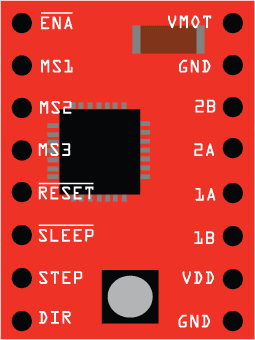
 Design with A4988 Stepper Motor Driver (Red) in Cirkit Designer
Design with A4988 Stepper Motor Driver (Red) in Cirkit DesignerIntroduction
The A4988 Stepper Motor Driver (Red) is a compact and versatile driver module designed for controlling bipolar stepper motors. It features adjustable current control, microstepping capabilities (up to 1/16 steps), and built-in thermal shutdown protection, making it an excellent choice for applications requiring precise motor control. This driver is widely used in 3D printers, CNC machines, robotics, and other motion control systems.
Explore Projects Built with A4988 Stepper Motor Driver (Red)
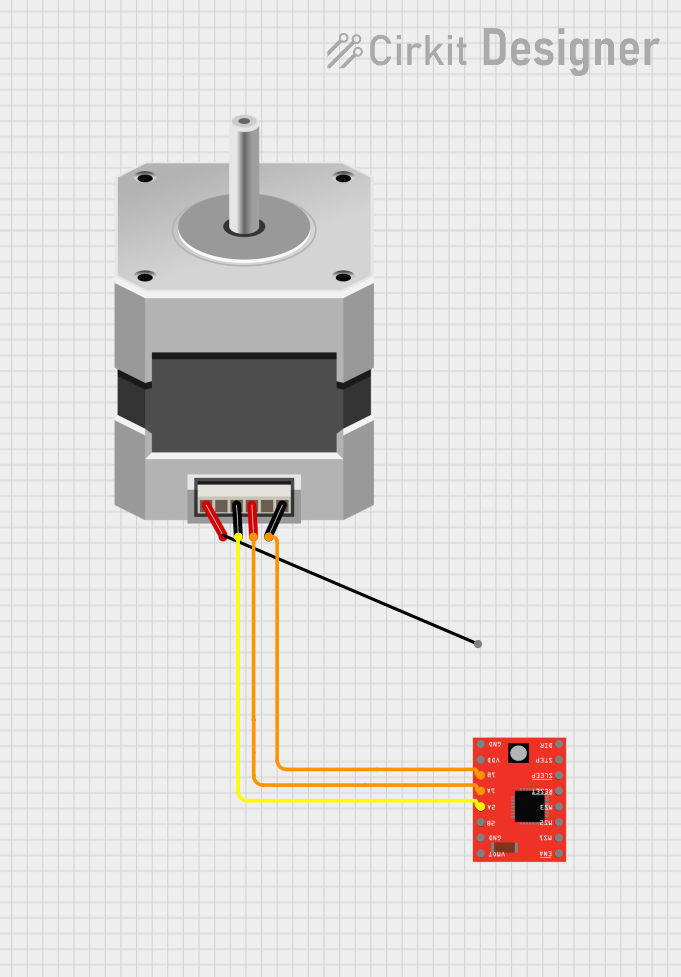
 Open Project in Cirkit Designer
Open Project in Cirkit Designer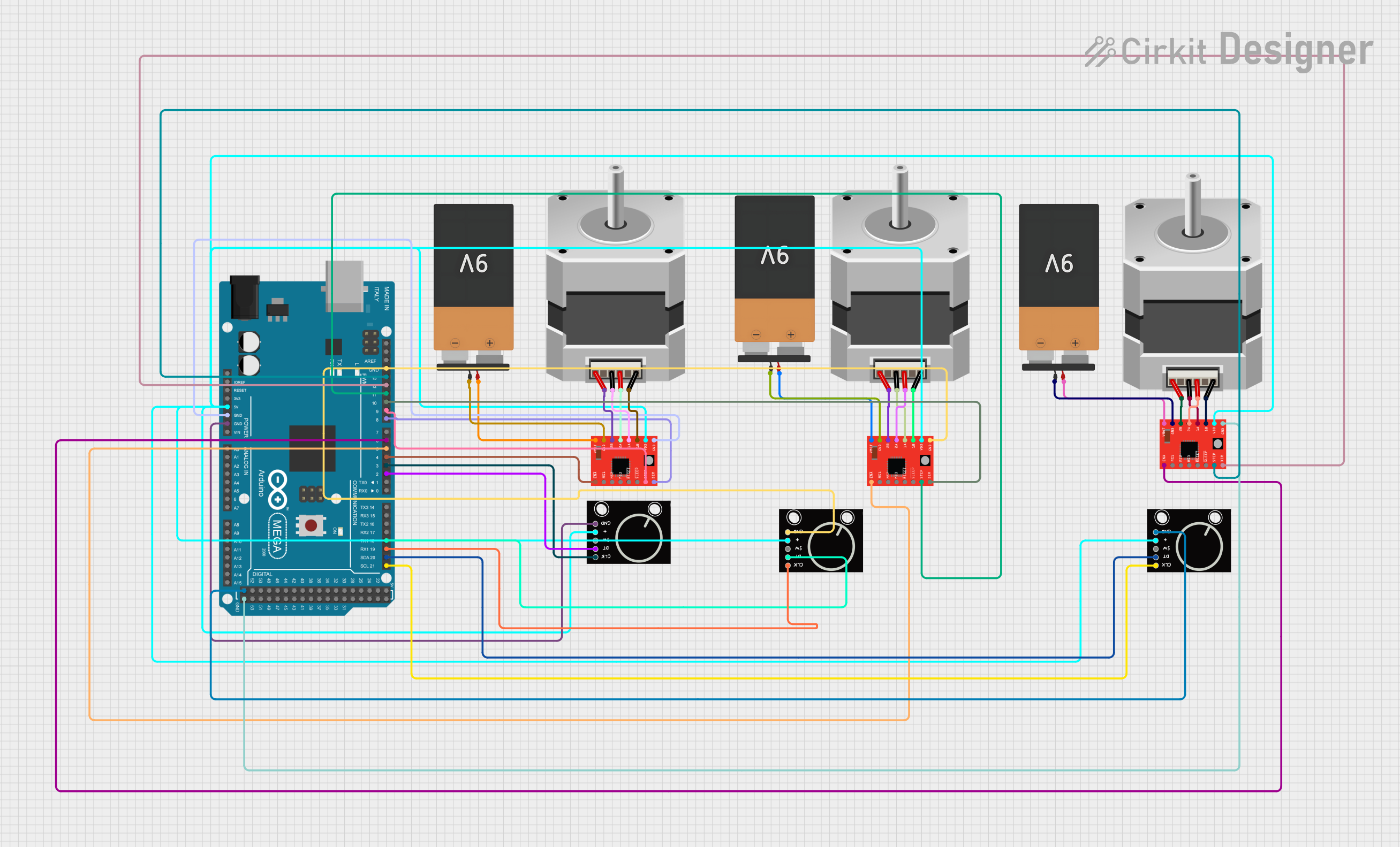
 Open Project in Cirkit Designer
Open Project in Cirkit Designer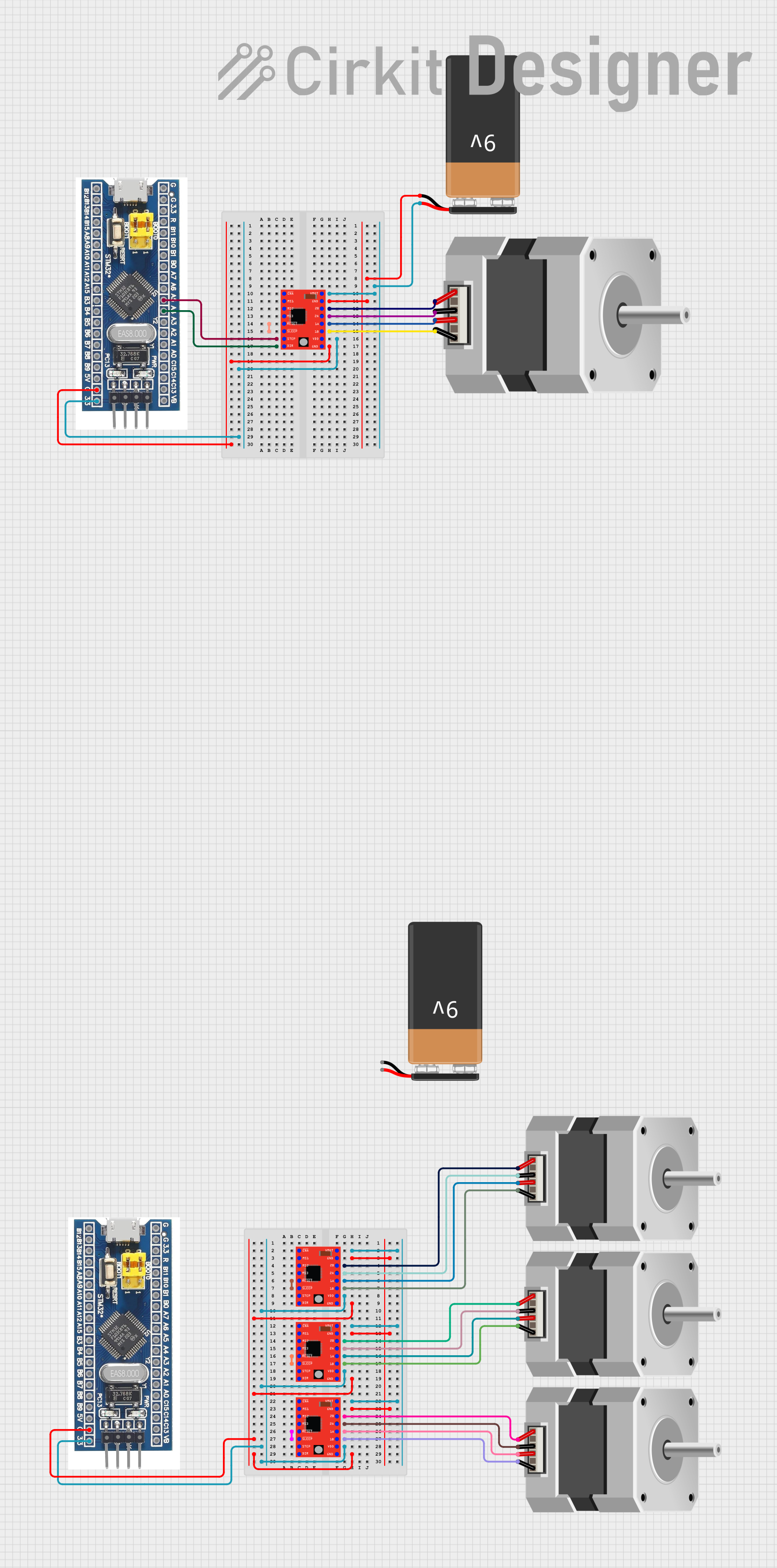
 Open Project in Cirkit Designer
Open Project in Cirkit Designer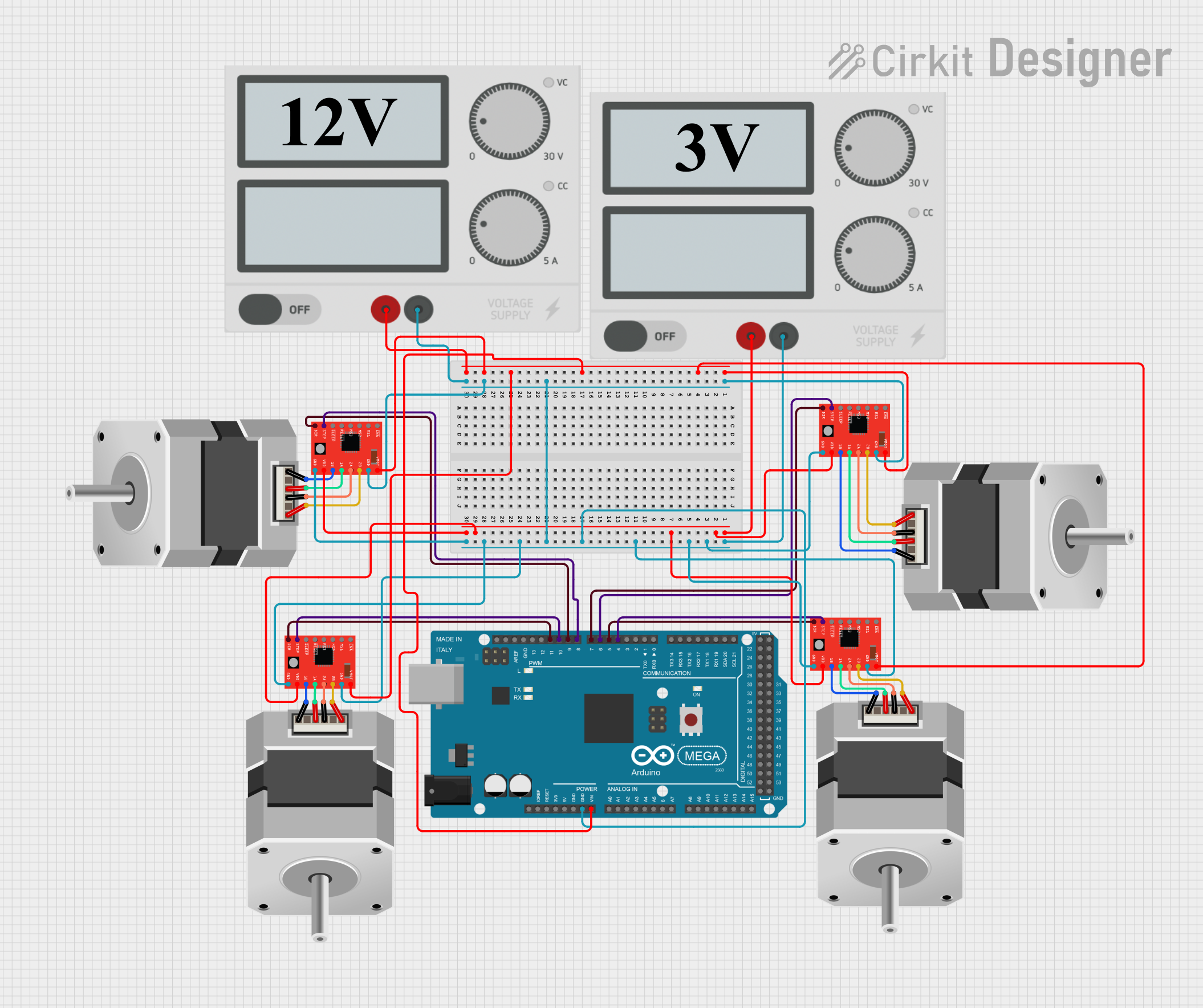
 Open Project in Cirkit Designer
Open Project in Cirkit DesignerExplore Projects Built with A4988 Stepper Motor Driver (Red)

 Open Project in Cirkit Designer
Open Project in Cirkit Designer
 Open Project in Cirkit Designer
Open Project in Cirkit Designer
 Open Project in Cirkit Designer
Open Project in Cirkit Designer
 Open Project in Cirkit Designer
Open Project in Cirkit DesignerCommon Applications and Use Cases
- 3D printers for precise movement of axes
- CNC machines for accurate tool positioning
- Robotics for controlling robotic arms or wheels
- Automated systems requiring stepper motor control
Technical Specifications
Below are the key technical details and pin configuration for the A4988 Stepper Motor Driver:
Key Technical Details
| Parameter | Value |
|---|---|
| Motor Type Supported | Bipolar Stepper Motors |
| Operating Voltage (Vcc) | 3.3V to 5V |
| Motor Supply Voltage (VMOT) | 8V to 35V |
| Maximum Output Current | 2A per coil (with sufficient cooling) |
| Microstepping Modes | Full, 1/2, 1/4, 1/8, 1/16 steps |
| Logic Input Voltage | 3.3V or 5V (TTL compatible) |
| Thermal Shutdown | Yes |
| Overcurrent Protection | Yes |
| Dimensions | 20mm x 15mm x 11mm |
Pin Configuration and Descriptions
| Pin Name | Pin Number | Description |
|---|---|---|
| VMOT | 1 | Motor power supply (8V to 35V). Connect to the stepper motor power source. |
| GND | 2, 3 | Ground pins. Connect to the power supply ground. |
| VDD | 4 | Logic voltage supply (3.3V to 5V). |
| STEP | 5 | Step input. A rising edge on this pin advances the motor one step. |
| DIR | 6 | Direction input. High or low determines the motor's rotation direction. |
| ENABLE | 7 | Enable input. Low to enable the driver, high to disable it. |
| MS1, MS2, MS3 | 8, 9, 10 | Microstepping mode selection pins. Configure step resolution. |
| RESET | 11 | Resets the driver. Active low. |
| SLEEP | 12 | Puts the driver into low-power sleep mode. Active low. |
| A1, A2 | 13, 14 | Outputs for one motor coil (A). Connect to the stepper motor. |
| B1, B2 | 15, 16 | Outputs for the other motor coil (B). Connect to the stepper motor. |
Usage Instructions
How to Use the A4988 in a Circuit
Power Connections:
- Connect VMOT to the motor power supply (8V to 35V).
- Connect GND to the ground of the power supply.
- Connect VDD to the logic voltage supply (3.3V or 5V).
Motor Connections:
- Connect the stepper motor's two coils to A1, A2 and B1, B2. Ensure the correct pairing of the motor wires.
Control Pins:
- Use the STEP pin to control the motor's steps. Each rising edge moves the motor one step.
- Use the DIR pin to set the motor's rotation direction (high or low).
- Configure microstepping by setting MS1, MS2, and MS3 according to the desired resolution:
- Full step: MS1 = 0, MS2 = 0, MS3 = 0
- 1/2 step: MS1 = 1, MS2 = 0, MS3 = 0
- 1/4 step: MS1 = 0, MS2 = 1, MS3 = 0
- 1/8 step: MS1 = 1, MS2 = 1, MS3 = 0
- 1/16 step: MS1 = 1, MS2 = 1, MS3 = 1
Current Limiting:
- Adjust the current limit using the potentiometer on the module. This prevents overheating and protects the motor.
Enable/Disable:
- Use the ENABLE pin to enable or disable the driver. Pull it low to enable and high to disable.
Arduino UNO Example Code
Below is an example of how to control a stepper motor using the A4988 and an Arduino UNO:
// Define control pins
#define STEP_PIN 3 // Connect to STEP pin on A4988
#define DIR_PIN 4 // Connect to DIR pin on A4988
void setup() {
pinMode(STEP_PIN, OUTPUT); // Set STEP pin as output
pinMode(DIR_PIN, OUTPUT); // Set DIR pin as output
digitalWrite(DIR_PIN, HIGH); // Set initial direction (HIGH = clockwise)
}
void loop() {
// Generate steps to move the motor
for (int i = 0; i < 200; i++) { // 200 steps for one revolution (1.8°/step)
digitalWrite(STEP_PIN, HIGH); // Step pulse high
delayMicroseconds(1000); // Wait 1ms (adjust for speed)
digitalWrite(STEP_PIN, LOW); // Step pulse low
delayMicroseconds(1000); // Wait 1ms
}
delay(1000); // Wait 1 second before changing direction
// Change direction
digitalWrite(DIR_PIN, LOW); // Set direction to counterclockwise
delay(1000); // Wait 1 second before next loop
}
Important Considerations and Best Practices
- Heat Management: The A4988 can get hot during operation. Use a heatsink or active cooling if necessary.
- Current Limiting: Always set the current limit to match your stepper motor's rated current to avoid damage.
- Power Supply: Ensure the motor power supply voltage is within the specified range (8V to 35V).
- Decoupling Capacitors: Add a 100µF capacitor across VMOT and GND to reduce voltage spikes.
Troubleshooting and FAQs
Common Issues and Solutions
Motor Not Moving:
- Check all connections, especially the motor coils (A1, A2, B1, B2).
- Verify that the STEP pin is receiving pulses.
- Ensure the ENABLE pin is pulled low.
Motor Vibrates but Doesn't Rotate:
- Verify the correct pairing of motor wires for the coils.
- Check the microstepping configuration (MS1, MS2, MS3).
Driver Overheating:
- Ensure the current limit is set correctly using the potentiometer.
- Add a heatsink or active cooling to the driver.
Motor Moves Erratically:
- Check for noise or interference on the control signals.
- Ensure the power supply voltage is stable and within range.
FAQs
Q: Can I use the A4988 with a unipolar stepper motor?
A: No, the A4988 is designed for bipolar stepper motors only.
Q: How do I calculate the current limit?
A: Use the formula: Current Limit = VREF / (8 × RS), where RS is the sense resistor value (typically 0.1Ω).
Q: Can I daisy-chain multiple A4988 drivers?
A: Yes, but ensure each driver has its own control signals and power supply connections.
Q: What happens if I exceed the maximum current?
A: The driver will activate overcurrent protection, but prolonged overcurrent can damage the module. Always set the current limit properly.